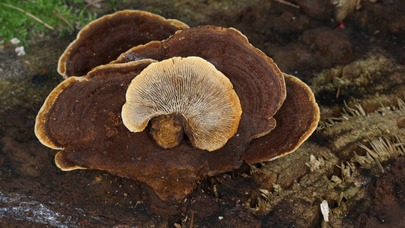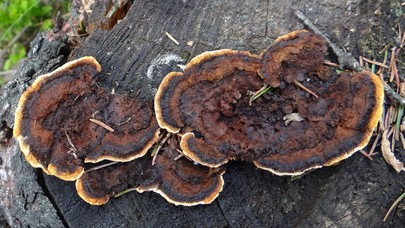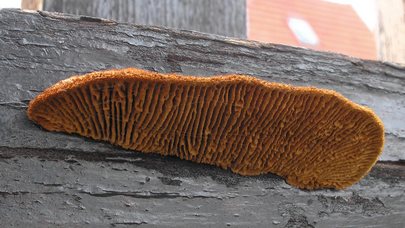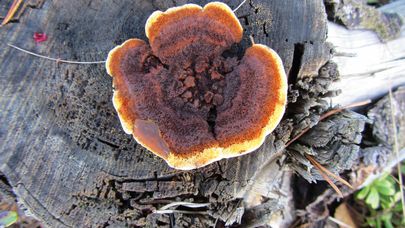Gloeophyllum sepiarium
Description
Gloeophyllum sepiarium is an inedible wood decay fungus. When fresh and very young its cap is more or less orange, but as it matures brown colors replace the orange from the center outwards and it may even have a greenish tinge. The orangey gills are fairly distinctive. It is grown in thin, dark brown/green brackets on dead conifers. Often found on wood in lumberyards, the fruiting body grows for only one year, and produces spores in late summer and autumn.
Common names: Conifer Mazegill, Rusty-Gilled Polypore, Yellow-Red Gill Polypore, Yesquero de las cercas (Spain), Lenzite des clôtures (France), Zaun-Blättling (German).
Mushroom Identification
Ecology
Saprobic on the deadwood of conifers and, occasionally, hardwoods (especially those, like quaking aspen, that grow in conifer-dominated ecosystems); causing a brown rot; growing alone or gregariously; appearing in woods, but not infrequently found on lumber in urban settings; annual or reviving to be perennial; summer and fall (and overwinter in warm climates); widely distributed in North America.
Cap
Single or compound (and then either fused laterally or with loosely arranged lobes arising from a central point); up to about 12 cm across and 8 cm deep; semicircular, irregularly bracket-shaped, or kidney-shaped; flattened-convex; velvety to hairy; rugged; with concentric zones of texture and color; at first yellow to orange, becoming yellow-brown to dark brown or nearly black toward the point of attachment but usually remaining yellow to orange on the growing margin.
Gills
Irregular and often fusing; fairly close; often mixed with slot-like pores; edges yellow-brown becoming darker brown with age; faces creamy to pale brownish, darkening with age; up to about 1 cm deep.
Flesh
Dark rusty brown or dark yellow-brown; corky.
Spore Print
White.
Chemical Reactions
KOH black on flesh.
Microscopic Features
Spores 9-13 x 3-5 µ; smooth; cylindric; inamyloid; hyaline in KOH. Basidia often elongated. Cystidia cylindric; up to about 100 x 10 µ. Hyphal system trimitic.
Similar Species
Include Trametes betulina, and Trametes versicolor.
Medicinal Properties
Anti-tumor effects. The culture mycelia and fruit bodies of G. sepiarium showed 80% and 60% inhibition against Sarcoma 180 cancer, respectively, while the fruit bodies showed 60% inhibition against Ehrlich solid cancer (Ohtsuka et al., 1973).
History
Synonyms: Agaricus sepiarius Wulfen 1786 (basionym); Daedalea sepiaria (Wulfen) Fries 1821; Lenzites sepiaria (Wulfen) Fries 1838; Merulius sepiarius (Wulfen) Schrank 1789.
The term “sepiarium” comes from the Latin “sepiárius” = of the cuttlefishes, of the ink (sépia = cuttlefish, ink + ater = dark, black).
Photo sources:
Photo 1 - Author: Quartl (CC BY-SA 3.0)
Photo 2 - Author: Holger Krisp (CC BY-SA 4.0)
Photo 3 - Author: Jerzy Opioła (CC BY-SA 3.0)
Photo 4 - Author: Andreas Kunze (CC BY-SA 3.0)
Photo 5 - Author: Anneli Salo (CC BY-SA 3.0)





